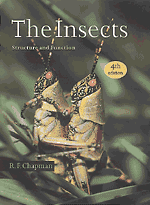Book contents
- Frontmatter
- Contents
- Preface
- Acknowledgments
- PART I The Head, Ingestion, Utilization and Distribution of Food
- PART II The Thorax and Locomotion
- PART III The Abdomen, Reproduction and Development
- PART IV The Integument, Gas Exchange and Homeostasis
- PART V Communication
- 20 Nervous system
- 21 Endocrine system
- 22 Vision
- 23 Mechanoreception
- 24 Chemoreception
- 25 Visual signals: color and light production
- 26 Mechanical communication: producing sound and substrate vibrations
- 27 Chemical communication: pheromones and chemicals with interspecific significance
- Taxonomic index
- Subject index
25 - Visual signals: color and light production
Published online by Cambridge University Press: 05 June 2012
- Frontmatter
- Contents
- Preface
- Acknowledgments
- PART I The Head, Ingestion, Utilization and Distribution of Food
- PART II The Thorax and Locomotion
- PART III The Abdomen, Reproduction and Development
- PART IV The Integument, Gas Exchange and Homeostasis
- PART V Communication
- 20 Nervous system
- 21 Endocrine system
- 22 Vision
- 23 Mechanoreception
- 24 Chemoreception
- 25 Visual signals: color and light production
- 26 Mechanical communication: producing sound and substrate vibrations
- 27 Chemical communication: pheromones and chemicals with interspecific significance
- Taxonomic index
- Subject index
Summary
THE NATURE OF COLOR
Color is produced from white light when some of the wavelengths are eliminated, usually by absorption, and the remainder are reflected or transmitted. The wavelengths of the reflected or transmitted component determine the color observed (Fig. 25.1). If all wavelengths are reflected equally the reflecting surface appears white; if all are absorbed the appearance is black.
Differential reflection of light to produce color occurs in one of two ways: the physical nature of the surface may be such that only certain wavelengths are reflected, the remainder being transmitted, or pigments may be present which, as a result of their molecular structure, absorb certain wavelengths and reflect the remainder. Colors produced by these methods are known, respectively, as physical (or structural) and pigmentary colors. In either case, the color observed is dependent on the wavelengths of light in which the insect is viewed, usually sunlight or white light. Insects do not fluoresce or, with a few exceptions, luminesce (section 25.7).
The colors of insects are usually produced by structures or pigments in the cuticle or epidermis, but, if the cuticle is transparent, the hemolymph, fat body, or even gut contents may contribute to the insect's color.
PHYSICAL COLORS
Surface structures are mainly responsible for the production of whites, blues and iridescent colors. Such colors may be produced by scattering, interference or diffraction.
Reviews: Hinton, 1976; Neville, 1975
Scattering
Light may be scattered, that is, reflected in all directions, by irregularities of a surface or by granules just beneath it.
- Type
- Chapter
- Information
- The InsectsStructure and Function, pp. 655 - 679Publisher: Cambridge University PressPrint publication year: 1998
- 2
- Cited by



